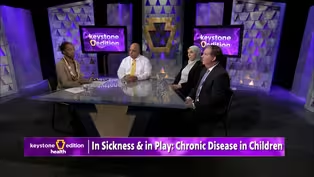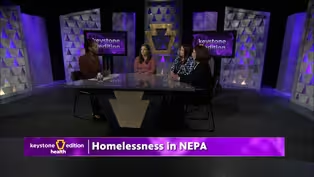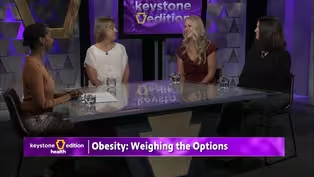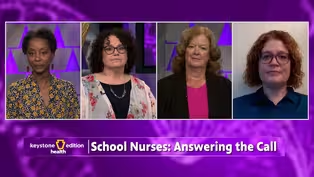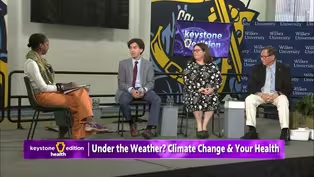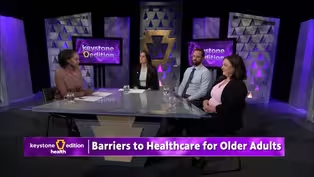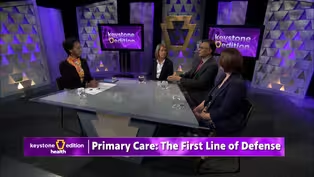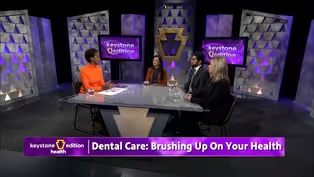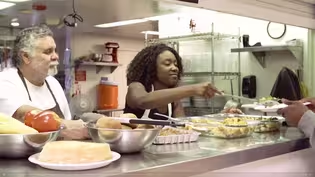Keystone Edition
Putting Food on the Table: Food Insecurity
3/25/2021 | 27m 2sVideo has Closed Captions
In Northeast PA, multiple organizations are working to keep their communities well-fed
Do you know where your next meal will come from? Will you be able to afford a nutritious meal for yourself and your family? In the year 2017 alone, 1.5 million Pennsylvanians lacked access to affordable food and were at risk of going hungry. In Northeastern PA, multiple organizations are working every day to lower that number and keep their communities well-fed, even in areas known as food deserts
Problems playing video? | Closed Captioning Feedback
Problems playing video? | Closed Captioning Feedback
Keystone Edition is a local public television program presented by WVIA
Keystone Edition
Putting Food on the Table: Food Insecurity
3/25/2021 | 27m 2sVideo has Closed Captions
Do you know where your next meal will come from? Will you be able to afford a nutritious meal for yourself and your family? In the year 2017 alone, 1.5 million Pennsylvanians lacked access to affordable food and were at risk of going hungry. In Northeastern PA, multiple organizations are working every day to lower that number and keep their communities well-fed, even in areas known as food deserts
Problems playing video? | Closed Captioning Feedback
How to Watch Keystone Edition
Keystone Edition is available to stream on pbs.org and the free PBS App, available on iPhone, Apple TV, Android TV, Android smartphones, Amazon Fire TV, Amazon Fire Tablet, Roku, Samsung Smart TV, and Vizio.
Providing Support for PBS.org
Learn Moreabout PBS online sponsorshipMore from This Collection
Healthcare is constantly changing as technology finds new and better ways to help people live longer, healthier lives. Host Tonyehn Verkitus will address the issues that are important to the people in our community, including the ongoing pandemic, concerns about vaccines, food deserts, childhood trauma and child abuse, mental health, environmental issues, and the rising cost of staying healthy wit
Domestic Violence: Breaking the Silence
Video has Closed Captions
Access to the right resources can make facing this challenge a little easier for families (26m 59s)
In Sickness and in Play: Chronic Disease in Children
Video has Closed Captions
About 25% of children in the US aged 2 to 8 years have a chronic health condition (27m)
Video has Closed Captions
Homelessness can happen to anyone at any age or socio-economic status. (26m 59s)
Video has Closed Captions
As we raise the visibility on Transgender young adults and embrace them within our culture (26m 59s)
Video has Closed Captions
Obesity is a serious risk factor many try to avoid when developing healthy eating habits. (27m)
School Nurses: Answering the Call
Video has Closed Captions
What can our school districts do to help retain and recruit nurses for future generations? (27m)
Under the Weather? Climate Change & Your Health
Video has Closed Captions
How does climate change impact individual and public health? (54m 59s)
Barriers to Healthcare of Older Adults
Video has Closed Captions
What progress have local organizations made in addressing these challenges? (27m)
Primary Care: The First Line of Defense
Video has Closed Captions
When was the last time you saw your primary care doctor? (27m)
The Smallest Victims: Child Abuse & Trafficking
Video has Closed Captions
What are the signs to know to spot child abuse and even possible trafficking? (27m)
Dental Care: Brushing Up on Your Health
Video has Closed Captions
How can providers make dental care more affordable and accessible? (26m 59s)
Video has Closed Captions
What does the cannabis industry mean for Northeastern and Central Pennsylvania? (26m 59s)
Providing Support for PBS.org
Learn Moreabout PBS online sponsorship- [Facilitator] Live from your Public Media studios, WVIA presents Keystone Edition Health, a public affairs program that goes beyond the headlines to address issues in Northeastern and Central Pennsylvania.
This is Keystone Edition Health.
And now, moderator Tonyehn Verkitus.
- Good evening and welcome to Keystone Edition Health, I'm Tonyehn Verkitus, thank you for joining us.
If you have ever struggled to put healthy food on your family's table or wondered how you'll afford your next meal, you are not alone.
Fortunately, food banks and organizations have stepped up to the plate not only to provide food, but work on addressing the root causes of what is known as food insecurity.
If you have a question, call one 1-800-326-9842, email at keystone@wvia.org or on social media #keystonehealth.
First, WVIA's Paul Lazar will tell us more about this issue.
- [Paul Lazar] What we eat fuels our daily lives and our overall health.
But for many, putting nutritious food on the table is often difficult or impossible.
Feeding America reports that one in nine people and one in seven children in Pennsylvania struggle with hunger according to their 2020 map, the Meal Gap Study.
Food insecurity is the lack of access to enough food for a healthy act of life for all members of a household and limited or uncertain access to nutritionally adequate foods.
To address the meal gap, Feeding America relies on partner food banks to target the needs of their communities.
In Northeast Pennsylvania, the Commission on Economic Opportunities, Weinberg Food Bank and the Central Pennsylvania Food Bank sponsor programs to combat food insecurity and ensure those in need have options to put healthy food on their tables.
The Covid-19 pandemic caused an economic recession that ended years of declining food insecurity rates, Feeding America reports.
They project one in eight people across the United States will experience food insecurity this year.
Addressing food insecurity goes beyond simply providing food and material goods.
Economic programs can help build self sufficiency and give people their own security.
CEO focuses not only on the mission of the Food Bank, but also on responding to homelessness and advocating for environmental sustainability and utility restructuring.
I'm Paul Lazar for Keystone Edition Health.
- Tonight we are joined by Allison Hess, Vice President of Health Services at Geisinger, Gretchen Hunt also joins us in studio from the Commission on Economic Opportunity and Weinberg Food Bank, we also have Joe Arthur, Executive Director of the Central Pennsylvania Food Bank.
If you have a question for one of our guests, call 1-800-326-9842, email at keystone@wvia.org or on social media #keystonehealth.
Welcome to all of you, thank you for joining us this evening.
As we all know, food insecurity isn't just about access, it could be about living in a food desert, it could be about not having transportation and I'm looking forward to you all sharing with us how you're not only improving access but also providing healthy benefits as well.
Allison, can you tell us a little bit about the mission at the Fresh Food Farmacy?
- Yeah, absolutely.
So we started the Fresh Food Farmacy really with the goal of transforming healthcare using food as medicine to treat type 2 diabetes.
So taking an underlying issue of food insecurity and really using food as medicine in a creative way to try and treat a chronic condition.
- Well, I am a avid believer in food as medicine, I have proof positive myself because I have autoimmune disease.
Joe, I know at the core of some of what you do is this belief in food as medicine, can you tell us how that works in serving your clients as well?
- Sure, we've been on this journey for about 10 years to provide healthier food, so most folks think of food banks, they think of kind of the boxes, bottles and cans that we put in our cupboards but we introduced fresh produce and fresh dairy and frozen meats and frozen fruits and veggies quite a while ago and have been building that but it was only recently, about three or four years ago that we started to work with our healthcare partners namely Geisinger Health System to really focus on the client, not just on the amount of food we were providing but to focus on the client and it's been a learning experience that we've used to shape our programs and we can see in the background the type of food that we feature now looks like that on the screen.
You don't think of food banks that way but with our healthcare partners, that's the journey we've been on.
- Gretchen, your organization has been combating poverty since 1965, can you tell us how many counties you serve and how many meals you believe you're providing?
- Sure, so the Commission on Economic Opportunities, Weinberg Regional Food Bank serves four counties in Northeast Pennsylvania, we serve Luzerne and Lackawanna, Wyoming and Susquehanna counties and last year in 2020, we provided 19.5 million pounds of food, which is just around 16 million meals when you think about what does a pound equal versus a meal.
- Food banks rely not just on donations but also on volunteers to keep food flowing into the community.
We met a CEO volunteer this week to hear more about their mission.
- I first heard about CEO and this particular food pantry back in July and it just represented a need that I knew was immediate and something that I could volunteer with.
As a volunteer, I load food boxes which are distributed throughout Northeast Pennsylvania to local food pantries in all the places.
So there's a certain nutritional value that's assigned to each food box that we deliver.
So there's so many different types of canned goods, boxed goods and they're meant to all be packed in one place.
Some of the boxes are for the limits of one week and other boxes are for a month.
There are large trucks that come here, this is a warehouse facility, so they pick up the boxes, they distribute them to the local distribution points and they may be food pantries or local food areas that they can be distributed to smaller vans and then distributed much more locally.
As you know, this is a rural area, the ability to be able to get that systematic distribution by going to the local food pantries is optimal.
We do see a lot of student volunteers and people from all walks of life that are up here that just wanna help out.
There's people from all ages that come in.
So it's not just older people, since we started out with the students, we still see a steady stream of those come in but there's been more middle aged and older volunteers that arrive to help out.
We definitely are looking for more volunteers as we go through this period, we just recently moved into this new warehouse facility so not as many people know where it's located but yes, we're always looking for volunteers for the better, we can do more boxes and it makes it a lot easier on the volunteer staff when there's more people here.
- Gretchen, clearly, it takes quite a few moving pieces to get the food from your warehouse to your clients.
But how do you get the food to the warehouse?
Can you tell us a little bit about the logistics and how far some of this food may be coming?
- Sure, so our food really comes from three primary sources, we get food that's donated and when we talk about donated food, we're looking at donations really from the entire food system.
And that could be from growers or producers all the way up to the retailers.
And those contributions, those donations of food come from really all over the United States.
As a member of Feeding America, we have access to contributions from all over the country.
So other communities that may have excess of one type of product can give that product up to the network and we can get it here in Northeast Pennsylvania.
We also get food from government commodity programs through the USDA so programs that support farmers, that product that is financially supporting farmers comes to the Food Bank and we're able to give that to families who need it and the third area of where food comes from is wholesale purchase.
And over the past year, we've really seen an increase in how much food that we have to purchase just of the strains on the food system.
We all have seen the shortages in the grocery stores over the past year and the struggle that has occurred and just the logistics of getting food from point A to point B.
And that's affected how the food banks operate when we rely so heavily on donated product.
And so we're really filling in the gaps by making purchases of food so some of the food that you saw in that video with the volunteers packaging, that's a mix of product but really seeing a lot more need to purchase food product.
- Allison, can you tell us a little bit about the value of having a fresh food farmacy in our community?
How are you serving the people that come to visit you?
- Yeah, so particularly in the Scranton community, we placed that fresh food farmacy in a food desert.
So it was a designated area that we identified as having a high concentration not only of individuals who had type two diabetes but also an area that was designated as a food desert.
So we looked at the community health needs assessment, we looked at a lot of data in the area to try and understand where it made sense to put that particular location and it really has brought value because it gives members of that community not just the patient but the entire household the opportunity to be able to access fresh fruits and vegetables as Joe mentioned, it's like walking into a grocery store and so you have your selection of proteins, lean meats, whole grains, eggs and individuals can come in and get meals for up to 10 meals a week so they can shop and there's recipes available and there's additional services and educational services available as in the program.
- And Scranton was not the first location, so how many locations do you have now?
- So we have three locations, our first location was in Shamokin, Pennsylvania, our second one was in Scranton and then the third location is actually in Lewistown, Pennsylvania, - Joe, as a partner to different healthcare organizations, you're providing them with fresh food for their clients but can you give us an idea of what the menu looks like for the people that are coming directly to you?
- Yeah, I'd be happy to and while the Geisinger team is selecting foods that are specific to their patients that are diabetic, what we're trying to do is not have specialized foods that only go to those patients.
So what we're doing is introducing foods into our entire system that are based on those menus.
So they're not exotic foods, they are the same fruits and vegetables and meats and dairy products and other healthy foods that one can get at the grocery store in Pennsylvania, one can get at a farmers' market and so forth, grains, very healthy grains, healthy cereals so we're not just confining our healthy food sourcing to just the fresh food farmacies but mapping that over to as many of our local agencies or pantries that can handle that type of product and then we invest in our pantries.
We buy them freezers, we buy them refrigerators and the kind of equipment you need to handle the fresh and frozen products so it's been a very rapid evolution, I would say but we're very much informing our programs with our work with Geisinger and the Fresh Food Farmacies.
- Just out of curiosity, are you getting any of your fresh fruits and vegetables from local farmers?
I've often thought that it would be great if people could go glean at the end of the season because I know that there's often vegetables on the vine that maybe haven't been picked, do you do any of those sorts of activities or have volunteers that might?
- We actually do and I think Gretchen described how CEO Weinberg works and we're very similar, we'd like to say we source from farm to fork and during the season in Pennsylvania, during our agricultural seasons, we do actually have gleaning programs, many of our partner agencies do as well.
Our food bank has a... Really the heartland of Pennsylvania is kind of in Central Pennsylvania so we're blessed with an incredible amount of farms and orchards, other growers and other food producers.
So we're blessed by that, of course, our growing seasons don't really cover the whole calendar so we have to source nationally and actually through the port of Philadelphia, we have a coap of food banks that has a coap based in Philadelphia near the port, so we can get fresh produce all year long through surplus from the port.
So it's a pretty intricate system but we've worked hard to scale it up and we're very proud of that, in feeding America and in feeding Pennsylvania.
- Allison, can you share some success stories with us?
You've been at this for three years now so I'm sure you have some folks that have come through the program and have some good information to share.
- Yeah, we do.
There's a lot of great success stories but one in particular, just most recently, we had one of our first pilot patients in Shamokin, who joined the program, she just graduated the program and her journey is just really phenomenal so she's allowed us to share her story.
Her name is Rita and this is a picture of Rita in her cap and gown, she never graduated high school so we threw a little ceremony for her COVID style, socially distanced but she started the program as a type 2 diabetes patient who was very uncontrolled, her hemoglobin A1C was greater than 13, pretty consistently and for an extended period of time so she did not feel well, she was raising her grandchildren and caring for her ailing husband and really just said, I don't have time to do a program like this, and we really had to convince her that this was a good path for her and she begrudgingly joined the program and within a couple weeks was really starting to recognize the value of being able to provide healthy food not just for herself but for her entire household.
And she really embraced the education, she embraced the clinical care, the program has registered dieticians, community health workers and other clinicians that really wrap themselves around the patient and those are all services we had in our provider's office but we just moved their offices to the Fresh Food Farmacy location and so as our patients come in, they really feel like they're part of the family and they get everything they need right at that location and she just started thriving.
She ended up dropping her hemoglobin A1C to less than six which was a huge, huge accomplishment and research shows that for every one point reduction in hemoglobin AIC, there's about $1,000 in medical cost saving so she was using less medication, she was able to provide food for her family which took one more stress off of her plate and then additionally, she was losing weight, she lost about 40 pounds, she reduced her triglycerides, she reduced her blood pressure, she reduced her LDL, she started walking to class and just really not only changed her lifestyle but really brought her whole family and her grandchildren would come to the farmacy and pick out food with her and she just really did a phenomenal job.
And she's again has recently graduated and is doing really well.
- That's amazing, I like to hear stories like that, success stories always sound nice especially right now.
Unfortunately, it's hard to have conversations right now without discussing Covid-19.
Gretchen, can you tell us a little bit about not only how COVID has impacted you in terms of serving larger numbers of people but what other ways has COVID impacted you?
- Sure, so the obvious that we're moving more food and we're serving more families and more people than honestly, I think we ever really thought possible.
Five years ago, we built a new facility for our food bank and we thought that it was gonna be big enough for 10 or 15 years and we're outgrowing it already.
We had the space that was shown on the video as our volunteer space and if we didn't have that, we could have never served the families and the people that we served.
And so adding additional space and making changes operationally and keeping everybody apart, things that you might not think about but a lot of us can work at home, right?
Our drivers cannot, our warehouse staff cannot and so we took extra precautions to make sure that our drivers that were going out to our partner agencies to make food deliveries, that they didn't come into the warehouse and so they parked their truck, backed it up to the dock and waited and the internal staff would load the vehicle.
So we made a lot of changes operationally to just keep everybody safe and at work and it worked.
So we're proud to say that we didn't ever have to pause operations or send people home for fear of spreading COVID and we continue to do that.
And on the side of our partner agencies, really things changed.
As Allison mentioned, at Fresh Food Farmacy and a lot of our pantries people got to choose what they wanted, they got to come inside and shop and we want that but that wasn't safe anymore.
And so we really switched everything up and most of our partners went to a drive-through model where families could just drive up, provide some basic information through the car window to the volunteers and then pop their trunk and we still operate that way.
We're excited about warm weather in the spring time now but really looking forward to being able to come back indoors and give people the choices that they used to have.
- Joe, besides hunger, can you tell us other ways that food insecurity impacts our communities?
- Yeah, it's really a devastating impact on the individual, the family but really the whole community can be impacted.
Of course, a child that does not have enough nutritious food can't really concentrate in school, can't really learn, we see what a challenge it is in COVID with the school situation but for a hungry child, it's like that all the time if they don't have enough healthy food.
And the same for the family of that child and we think of our veterans, we think of our elderly folks.
I'm not in healthcare but I know from experience that when someone is lacking nutrition, they can present as if they have other health issues, they could be confused and so forth.
And then of course, how do you work?
How do you earn for your family and for yourself if you don't really have the energy that you need from nutritious food?
So it just kind of goes through someone's entire life and limits them and at a community level, think of what that does when large portions of the community are challenged that way and then we see what impact that has and it could even lead to unstable families, even crime has increased when folks can't get enough food.
So it's just really something that is a societal level issue not just a single individual but of course we have to solve it one person at a time.
So we have food insecurity as an issue for the community and for the nation.
We're proud to be working on it with friends like Gretchen, with friends like Geisinger but unfortunately, COVID has set us back and put more people in that situation so working hard to bring us forward and recover.
- Gretchen, as we solve hunger in the community, once it's solved, if that day comes, what ripple effects do you believe we'll see in our communities?
- Well, I think first you have to define what it means to solve hunger and to us, I think I could speak on behalf of Joe and Allison, we all agree that to us solving hunger really means that everybody, all people have regular, consistent, affordable access to not just any food, but high quality, nutritious food.
And so when all of those things happen, we see a change in public health and we know what that means, good public health and a healthy population means the opposite of everything Joe just said.
It means high quality education and healthy families and a healthy economy and we see that go across the board, but it all starts with food and I like to say that food is the foundation of life, food or healthy food are the building blocks of life and so really, that's where it starts.
- I'd like to ask each one of you if you could share with us how we can support the work that you're doing, how our neighbor non-profits can support you and also how corporations can support you.
Allison, what would you say is your biggest need right now?
- So I think with all of these programs and we have great partners like Central Pennsylvania Food Bank and CEO Weinberg, we could not do these programs without them.
I think any opportunity to support organizations like theirs that are continuing to source and provide food there's opportunities to directly support the Fresh Food Farmacy program and we certainly have many people in the community who do that and we greatly appreciate that as well.
As we continue to move forward, we're always looking for grant funding and other sources to help support but yeah, just that continued support and even referring people into the program, the programs are available and so if you know community members in need who could benefit from the program, we certainly welcome that as well.
- Gretchen, obviously with the increase in numbers of people that you're serving, plus the other programs that you do besides the food bank, I'm sure that you have some needs that you would like to have addressed as well if you'd like to share a few.
- Thank you.
At the top of our list are always financial contributions and volunteers.
You heard John, one of our dedicated volunteers talk about many hands make light work.
And one of the things standing between us and getting our partner agencies back into in-person, choice pantry service is having volunteers that are willing to be there.
It takes more volunteers to do that work and it takes volunteers to pack the boxes at the food bank so absolutely volunteers and then financial contributions to help support the continued purchase of wholesale product.
And in terms of organizations, we're partner with literally hundreds of organizations in the region but there's always room for more.
So when someone looks around and doesn't see a food pantry in their neighborhood or a program that's serving the need that they see, that's an opportunity to step up and whether that's a faith-based partner or a community partner or a neighborhood group, there's room for all of those partners in this solution.
- Joe, I know we don't have time for you to give us a full list of your needs but if you can just let folks know how they can contact you, give us a website address or something.
- Sure, I'd like to say first, if folks are actually in need of help, 211, pretty much throughout Pennsylvania, if you dial 211 and you need food assistance, we'll get a referral at the food banks whether it's Weinberg CEO or Central Pennsylvania Food Bank, so know that we could use the financial support all the time.
I just wanna do a big thank you.
Donors have been amazing, volunteers have been amazing, people, companies-- - Sorry to interrupt you Joe but we have to wrap up, I do apologize.
I would like to thank our panelists for participating and thank you for joining us.
For more information on this topic, please visit wvia.org.
and remember, you can rewatch this episode or any previous episode on demand anytime online or on the WVIA app.
For Keystone Edition, I'm Tonyehn Verkitus, thank you for watching.
(bright upbeat music)
Putting Food on the Table - Preview
Preview: 3/25/2021 | 30s | Airs Thursday, March 25th at 8p on WVIA TV (30s)
Providing Support for PBS.org
Learn Moreabout PBS online sponsorship
- News and Public Affairs

Top journalists deliver compelling original analysis of the hour's headlines.

- News and Public Affairs

FRONTLINE is investigative journalism that questions, explains and changes our world.












Support for PBS provided by:
Keystone Edition is a local public television program presented by WVIA

